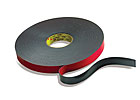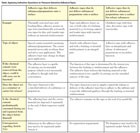
REACHTM VHBTM Tape for flame-retardant applications in the aerospace industry.
The REACH chemical regulation was enacted in December 2006 with the primary purpose of protection of human health and the environment, as well as the free movement of chemical substances in and through the European Union (EU).1This regulation affected not only preparations, but also articles. This article provides an overview of REACH, with a focus on how it affects pressure-sensitive tape products. Because of the complexity of REACH, all requirements cannot be covered.
What is REACH?
REACH stands for registration, evaluation, authorization and restriction of chemicals. It replaces over 40 regulations, including the European Inventory of Existing Chemical Substances (EINECS). To understand and properly implement the REACH regulation, several guidance documents, or REACH Implementation Projects (RIP), are being developed by the European Chemical Agency (ECHA).One purpose of REACH is to increase knowledge about existing high-volume-chemical substances marketed in the EU to determine what their commercial uses are and to ensure that they are properly managed.2It is estimated that there are 30,000 of these known high-volume substances. Another purpose of REACH is to ensure that risks from the use of substances of very high concern (SVHC) are either adequately controlled or justified by socio-economic grounds.3Based on the guidance within REACH, there are approximately 1,500 SVHC.
Preparations
There are different requirements for preparations (chemical products) and articles. The basic process preparations under REACH are as follows: that industry registers the substances it uses in its preparations (chemical products, over 1 metric ton per year) with the European Chemical Agency (ECHA) electronically. The ECHA creates a candidate list of possible SVHC by June 2009. The EU member states evaluate the available information for those possible SVHCs and place those substances of highest concern on Annex XIV of REACH. The ECHA evaluates the registrations of those substances and either prohibits or authorizes the use of those chemicals under certain conditions. In order to comply with REACH, the industry must know what is in products, how those products are used and how much of the substances they place into commerce. For most companies, it is a significant project to gather and analyze this information. In addition, the industry is required to provide physical, toxicological and environmental testing on substances with their registrations. Therefore, the industry bears the financial and risk management burdens of REACH.As a practical matter, the ECHA could not possibly handle all of the registrations at one time. The industry needs time to complete the toxicology and environmental testing. Commerce needs to continue in an orderly fashion. At the same time, there is some urgency to address the most hazardous highest-volume substances. To manage these concerns, the REACH regulation has a timeline built into it that allows for pre-registration of substances to give the ECHA an idea of the scope of registrations and to group companies by substances. The timeline then schedules the substance registrations over 11 years, with the highest-volume and highest-concern substances first. If a company pre-registers its substances, it can continue to sell products containing those substances as long as they register on time. If a substance is not pre-registered, then products containing that substance cannot be sold until the registration is complete. Substances in products that total less that 1 metric ton per year for a company do not require pre-registration or registration.

Table. Applying Indicative Questions to Pressure-Sensitive Adhesive Tapes
Articles
REACH is one of the first regulations of this type to also includes articles. Under REACH, an article is defined as an object that, during production, is given a special shape, surface or design that determines its function to a greater degree than does its chemical composition.4Most pressure-sensitive tapes are considered articles.Articles are generally considered less hazardous than preparations, but suppliers of articles have two obligations that must be met, both of which involve substances of very high concern. First, SVHC in articles must be notified if the substances are in products at 0.1 weight percent or higher and the total volume of the substance is greater than one metric ton per year for all products supplied in the EU. Notification is similar to registration in that the substance is identified, the volume stated and the use of the SVHC in the article is documented electronically to the ECHA. Notifications must be submitted to the ECHA by June 2011.5The second obligation is that the article supplier must communicate to their customers that the article contains a SVHC greater than 0.1 weight percent. The communication must include the name of the SVHC.
Since the 0.1 weight percent criteria is key to the article designation, it is important to understand how to determine the weight percent of components in an article. The substance concentration threshold of 0.1 % (w/w) applies to the article as produced or imported.6Thus, the weight percent is calculated using the whole article as supplied by the manufacturer.
REACH identifies a special group of articles called articles with intended release. For these articles, the supplier has included substances that are intended to be released in order for the article to function as planned. An example of an intended release is a fragrance added to a tape to make the tape more appealing to customers. Normal wear and tear during use or a release caused by unintended uses of the article is not an intended release. The article supplier must treat this type of article as both a preparation and an article. In the example of the fragrance added to a roll of tape, the fragrance would be treated as a preparation, and the rest of the roll of tape as an article. According to article 7(1) of REACH, the fragrance components would require pre-registration and registration, while the rest of the roll of tape would require notification and communication if the roll contained SVHC.
SVHC
Substances of very high concern are central to the authorization process in REACH and to the criteria for articles. Article 57 of REACH identified the groups of substances considered candidates to be SVHC. Those groups include: 1.) Carcinogens, mutagens, and reproductive toxins, category 1 and 2 as defined by Directive 67/548/EEC; 2.) Persistent, bioaccumulative and toxic (PBT) substances and very bioaccumulative and very persistent (vPvB) substances as defined by annex XIII of REACH; and 3.) Substances with endocrine disruption properties or having sufficient scientific evidence of probable serious effects on human health or the environment, which raises an equivalent level of concern as the other groups.7The candidate list will be compiled by the European Chemical Agency using this guidance. The candidate list must be finalized by June 2009. It is estimated that there will be 1,300-1,800 substances in this candidate list. A closer examination of this guidance shows that there are several sub-groups of substances, such as lead and its compounds, which comprise a large number of substances unto themselves.
The Society of Automotive Engineers (SAE) standard committee E1 worked on this issue and has developed a good estimate of the list of substances that will be on the final candidate list. They also looked at the sub-groups of substances and expanded them into lists of substances with individual Chemical Abstract Services (CAS) numbers. Their current list is approximately 2,900 substances. That list and a related standard are currently available from SAE as ARP9536 and AS9535.
The next step in the SVHC process is defined by Article 59 of REACH.8The member states of the EU select substances from the candidate list and develop dossiers documenting the properties of the substance that warrant its SVHC status. After review, those substances found to meet the criteria will be placed on Annex XIV of REACH. The substances on Annex XIV are the substances that will require authorization for continued use in preparations, and require notification communication when in articles. This process of placing a substance on Annex XIV will take time. It is estimated that approximately 50 substances will be added each year; thus, it will take well over 20 years to go through the candidate list. There is a prioritization process to help decide which substances will be reviewed first, defined in Article 58 of REACH.9The expectation is that the highest volume PBT and vPvB substances will be the first to be reviewed.
Although this process will take time, customers are likely to request information on the substances on the candidate list as soon as it is available. Some customers may use the candidate list as a “black list” and refuse to purchase products containing these substances. Thus, it is important to review preparations and article products as soon as possible for candidate list substances.
Tapes as Articles
As previously stated, most tape products are articles. RIP 3.8 is the specific REACH guidance for articles. The final draft of RIP 3.8 features a section that specifically addresses tapes. The authors of this guidance realize that tape components have different functions.10RIP 3.8 takes this into account and includes definitions and examples of how different types of tapes should be managed to meet REACH requirements. The table is from that guidance.11Tapes are divided into three different groups. The first group includes tapes that are really preparations on a carrier, such as waxes and mastics on a carrier, or thermally activated tapes that are designed to work with the addition of heat energy. Since the adhesive changes shape and sometimes changes chemical composition during use, these tapes are not considered articles. Products in this category should treat the carrier as an article and the rest of the construction as a preparation. The second group includes tapes that have an intended release. Examples in this group include a tape with a fragrance or insecticide added as a secondary feature. In this case, the fragrance or insecticide would be treated as a preparation, and the rest of the tape as an article. The third group includes all other types of single-coated, double-coated and transfer tapes. Almost all pressure-sensitive tapes fall into this group. All products in this group would be treated as articles and, thus, the primary concern would be SVHC content. If these tapes contain SVHC, they would require proper communication to customers and likely have notification requirements to the ECHA.
Summary of Affects on Tapes and Tape Suppliers
Although REACH has an affect on everyone in the supply chain for tapes sold in the EU, those effects depend on where a company is in the supply chain. Suppliers of raw materials to tape manufacturers in the EU will need to coordinate with those manufacturers so the registrations can be completed. Suppliers to tape manufacturers in other parts of the world will need to provide information on substances of very high concern in supplied materials. Manufacturers of tapes in the EU must consider the obligations for registration on preparations, as well as notification and communication obligations for articles. Tape manufacturers in other parts of the world that import tapes to the EU have to consider the notification and communication obligations for articles.Everyone needs to consider the issue of substances of very high concern. Because of the focus and likely future restrictions on these substances, customers will be interested in understanding which products contain these substances and likely will strongly encourage replacement of those substances as soon as possible. Suppliers and tape manufacturers need to be prepared to meet these new customer requirements.
Reprinted from a paper presented at PSTC TECH 31, May 2008.